|
This 1960 Fly-In held
by the
Experimental Aircraft Association (EAA) marks its 8th event. Before the
well-known Oshkosh, Wisconsin location became the de facto venue, the Fly-Ins
were held at Greater Rockford, Illinois, Airport. I'm not sure whether the
original EAA charter included restored aircraft or if it was constrained to
home-builts. All the airplanes shown in this 1961 issue of American Modeler
magazine are home-builts. At the time, the EAA boasted a membership of 9,000
consisting of 100 local chapters. Today, they claim more than 200,000 members
worldwide. That's a factor of 22 in 58 years, which is the equivalent of a
steady annual growth of about 5.5% over that period. To wit: 9,000 *
1.055^58 = 200,856.
Action A'Plenty at Experimental "Fly-In"
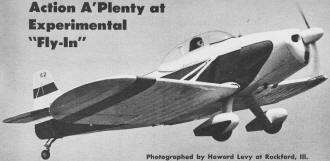 Photographed by Howard Levy at Rockford,
Ill. Photographed by Howard Levy at Rockford,
Ill.
When the Experimental Aircraft Association (9,000 members, 100 chapters throughout
the world) held its 8th annual "Fly-In" at Greater Rockford, Ill., Airport, 1,480
members registered, coming from the U.S., Canada, Alaska, New Zealand, and India.
Eighty-three home-built aircraft appeared, the majority flown-in, some towed, or
on trailers, because of travel distance, or unfinished state. Six incomplete helicopters
and autogiros built from plans were exhibited. The EAA "towable" design competition
was extended for 2 years since only 2 of these craft were completed, and they did
not meet the required flight status of 50 hours. EAA is a non-profit organization
dedicated to the advancement of aeronautical education, home built aircraft, and
private flying. During the first 9 months of 1960, membership increased 25% over
'59.
 Bryan II (left), second roadable aircraft
by Leland D. Bryan, is single-seater, all-metal pusher with twin booms and folding
wings, capable of traveling on highways under its own power ... where local regulations
permit. Has flown 65 hours, done 1,000 miles over the road on its own engine. Bryan II (left), second roadable aircraft
by Leland D. Bryan, is single-seater, all-metal pusher with twin booms and folding
wings, capable of traveling on highways under its own power ... where local regulations
permit. Has flown 65 hours, done 1,000 miles over the road on its own engine.
 Glad-Juan (right) is named after two "EAA
Widows" (Gladys and Juanita), wives of Massachusetts EAA'ers Joseph Rogers an" Charles
Grow. Basically a Model C "Baby Ace" this job sports modified Wittman nose gear.
Aft wing strut repositioned on body. Completed in 18 months; cost $1,100. Tops 108
mph with Continental A-65-8. Glad-Juan (right) is named after two "EAA
Widows" (Gladys and Juanita), wives of Massachusetts EAA'ers Joseph Rogers an" Charles
Grow. Basically a Model C "Baby Ace" this job sports modified Wittman nose gear.
Aft wing strut repositioned on body. Completed in 18 months; cost $1,100. Tops 108
mph with Continental A-65-8.
 Trefethen Stits "Playboy" SA-3A (left) was
built by Joan Trefethen, mother of 3. Joan added bubble canopy for 360 degree visibility.
On 85 hp Continental cruises at 120 mph; top speed 142. EAA President Paul Poberezny
completed "Pober Sport" (right) after 3 years work and $1,500. Spans 23 1/2 feet,
18 1/2 feet long. Gross weight 1,055 lbs. Cruises at 115 mph, tops 125 with 85 hp
Continental. Trefethen Stits "Playboy" SA-3A (left) was
built by Joan Trefethen, mother of 3. Joan added bubble canopy for 360 degree visibility.
On 85 hp Continental cruises at 120 mph; top speed 142. EAA President Paul Poberezny
completed "Pober Sport" (right) after 3 years work and $1,500. Spans 23 1/2 feet,
18 1/2 feet long. Gross weight 1,055 lbs. Cruises at 115 mph, tops 125 with 85 hp
Continental.

"Little Monster" (right) is original by Charles A. Wood using some Cub components.
Seats 1; spans 25' 9"; length 19'. Gross weight 950 lbs. Cruises at 95 mph, top
is 120 with Continental A-65-8 power. Service ceiling 12,000 ft.
 "Our Lady" (left) was constructed for $750
by Joseph Coser and John Oonk. Fuselage from cockpit aft is Luscombe tailcone, rebuilt
and narrowed. Wings are inboard sections from Luscombe; ailerons and tail assembly
cut-down from Luscombe. Spans 19 1/2 feet; tops 125 with Continental A-75. "Our Lady" (left) was constructed for $750
by Joseph Coser and John Oonk. Fuselage from cockpit aft is Luscombe tailcone, rebuilt
and narrowed. Wings are inboard sections from Luscombe; ailerons and tail assembly
cut-down from Luscombe. Spans 19 1/2 feet; tops 125 with Continental A-75.
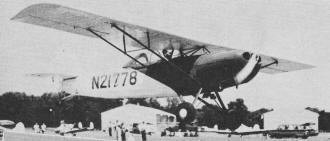 N21778 (right) is Player PN-55 built 20
years ago by William E. Player of Salt Lake City for $500 (ah, those good old low-cost
days!). With 65 hp Continental top speed is 100 mph, cruises at 87, lands at 50.
Seats 1, gross weight 800 lbs. Spans 30 feet, length 19 1/2 feet. Geodetic fuselage. N21778 (right) is Player PN-55 built 20
years ago by William E. Player of Salt Lake City for $500 (ah, those good old low-cost
days!). With 65 hp Continental top speed is 100 mph, cruises at 87, lands at 50.
Seats 1, gross weight 800 lbs. Spans 30 feet, length 19 1/2 feet. Geodetic fuselage.
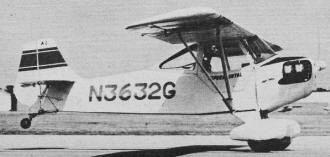 "Tiny Champ" (left) can be converted to
open parasol type by removing doors and turtleback fairing. Built by Bill Warwick
in 18 months at cost of $1,200. Uses Continental A-65., cruises at 105 mph, tops
115. Gross weight 831 lbs. Spans 20 feet; length 19 feet. Ceiling 8,000 ft.; range
250 miles. "Tiny Champ" (left) can be converted to
open parasol type by removing doors and turtleback fairing. Built by Bill Warwick
in 18 months at cost of $1,200. Uses Continental A-65., cruises at 105 mph, tops
115. Gross weight 831 lbs. Spans 20 feet; length 19 feet. Ceiling 8,000 ft.; range
250 miles.
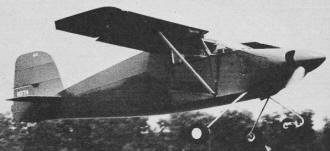 Wittman W-9L "B Gosh" (right) is by Steve
Wittman, Oshkosh, Wisc., popular "Old Man" of pylon midget racing who has had strong
influence on home-built movement. W-9L uses basic "Tailwind" airframe although front
fuselage and tail have been beefed up for larger 160 hp Lycoming which gives top
speed of 200 mph, cruising of 175. Lands at 60 mph. Gross weight 1,400 lbs; seats
two side-by-side. Wittman W-9L "B Gosh" (right) is by Steve
Wittman, Oshkosh, Wisc., popular "Old Man" of pylon midget racing who has had strong
influence on home-built movement. W-9L uses basic "Tailwind" airframe although front
fuselage and tail have been beefed up for larger 160 hp Lycoming which gives top
speed of 200 mph, cruising of 175. Lands at 60 mph. Gross weight 1,400 lbs; seats
two side-by-side.
 Modified "Playboy" by Ed Emanuel (left)
has wings clipped 1 foot at each end, fiberglass endplates, altered tail, fiberglass
pants, own design canopy, gorgeous finish. Took 3 1/2 years, $2,100. Continental
85-12FJH gives top speed of 135 mph; cruises at 120, lands at 50. Range 250 miles;
rate of climb 1,000'/min. Wing all-wood with fabric cover; fuselage and tail, steel
tube. Modified "Playboy" by Ed Emanuel (left)
has wings clipped 1 foot at each end, fiberglass endplates, altered tail, fiberglass
pants, own design canopy, gorgeous finish. Took 3 1/2 years, $2,100. Continental
85-12FJH gives top speed of 135 mph; cruises at 120, lands at 50. Range 250 miles;
rate of climb 1,000'/min. Wing all-wood with fabric cover; fuselage and tail, steel
tube.
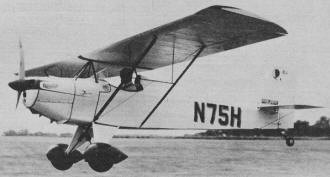 Everett "Squeek" Hepler constructed this
"Baby Ace" (right) for $585 in 11 months, then rebuilt craft to incorporate new
Square Model D tail, squared wing tips, closed cowling. Has logged more than 170
hours. Continental A-65-8 gives top speed of 120 mph, cruises at 100. Range 250
miles; rate of climb 1,000'/min. Wings, wood, fuselage and tail steel tube - all
fabric covered. Everett "Squeek" Hepler constructed this
"Baby Ace" (right) for $585 in 11 months, then rebuilt craft to incorporate new
Square Model D tail, squared wing tips, closed cowling. Has logged more than 170
hours. Continental A-65-8 gives top speed of 120 mph, cruises at 100. Range 250
miles; rate of climb 1,000'/min. Wings, wood, fuselage and tail steel tube - all
fabric covered.
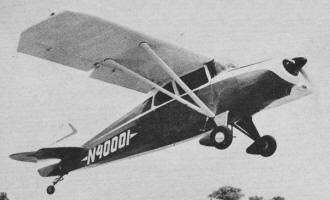 Four-seater (left) is Maule "Bee Dee" M-4
by airport operator-tailwheel manufacturer B. D. Maule. Test program for Approved
Type Certificate nearly complete. Continental 145 hp gives top speed of 158;
cruises at 150. Four-seater (left) is Maule "Bee Dee" M-4
by airport operator-tailwheel manufacturer B. D. Maule. Test program for Approved
Type Certificate nearly complete. Continental 145 hp gives top speed of 158;
cruises at 150.
 "Chuparosa" (Hummingbird, right) by Ray
Hegy, Marfa, Texas, cabinet furniture man, was one of smallest ships at Rockford.
Little bipe spans 13 feet, length 14 feet. Continental A-65 gives top speed of 150
mph. Will be detailed in Spring 1961 "Air Progress." "Chuparosa" (Hummingbird, right) by Ray
Hegy, Marfa, Texas, cabinet furniture man, was one of smallest ships at Rockford.
Little bipe spans 13 feet, length 14 feet. Continental A-65 gives top speed of 150
mph. Will be detailed in Spring 1961 "Air Progress."
Posted March 30, 2019
|